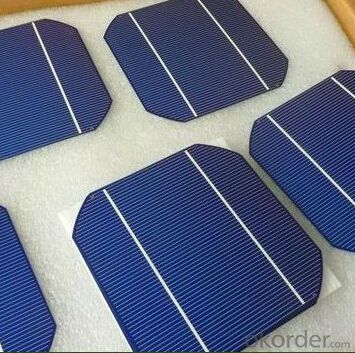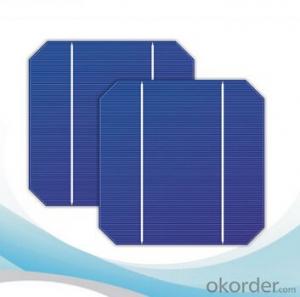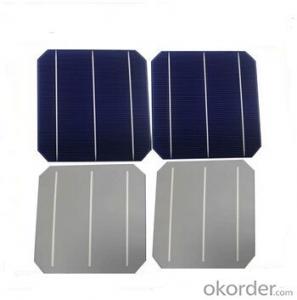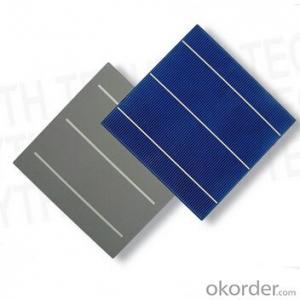Amorphous Solar Cells - High Quality Monocrystalline Solar Cells 16.25-18.00
- Loading Port:
- Shanghai
- Payment Terms:
- TT OR LC
- Min Order Qty:
- 1000 pc
- Supply Capability:
- 1000000 pc/month
OKorder Service Pledge
OKorder Financial Service
You Might Also Like
Solar Cells:
Solar cells is made by solar wafer, it has three categories of solar cell right now, monocrystalline polycrystalline and thin film,These cells are entirely based around the concept PN junction, which is the critical part of solar module, it is the part that can convert the light energy into electricity, the thickness is from 180um to 200um, with even busbars to conduct electricity, textured cell can decrease diffuse reflection; they are often electrically connected and encapsulated as a module. Photovoltaic modules often have a sheet of glass on the front (sun up) side, allowing light to pass while protecting semiconductor wafers from abrasion and impact due to wind-driven debris, rain, hail, etc. Solar cells are also usually connected in series in modules, creating an additive voltage. Connecting cells in parallel will yield a higher current;With high quality and stable quality. Our Cells can greatly improve the performance of Solar Modules.
Features:
1. High conversion efficiencies resulting in superior power output performance.
2. Outstanding power output even in low light or high temperature conditions
3. Optimized design for ease of soldering and lamination
4. Long-term stability, reliability and performance
5. Low breakage rate
6. Color uniformity
Solar Cells Advantage:
• High efficiency and stable performance in photovoltaic conversion.
• Advanced diffusion technique ensuring the homogeneity of energy conversion efficiency of the cell.
• Advanced PECVD film forming, providing a dark blue silicon nitride anti-reflection film of homogenous color and attractive appearance.
• High quality metal paste for back surface and electrode, ensuring good conductivity, high pulling strength and ease of soldering.
• High precision patterning using screen printing, ensuring accurate busbar location for ease with automatic soldering a laser cutting.
Specifications:
Product Mono-crystalline silicon solar cell
Dimension 156 mm x 156 mm ± 0.5 mm
Thickness 200 μm ± 30 μm
Front 1.5 ± 0.1 mm busbar (silver)
Silicon nitride antireflection coating
Back 3.0 mm continuous soldering pads (silver)
Back surface field (aluminum)
Size | 156mm x156mm ±0.5mm | |||||
Thickness | 190um ± 20um | |||||
Front surface(-) | 1.7mm bus bars(silver), blue anti-reflecting coating(Silicon nitride) | |||||
Back surface (+) | 3mm wide soldering pads(silver) back surface field(Aluminum) | |||||
TkVoltage | -0.346%/K | |||||
TkCurrent | +0.036%/K | |||||
TkPower | -0.47%/K | |||||
Efficiency(%) | Pmp(W) | Vmp(V) | Imp(A) | Voc(V) | Isc(A) | FF(%) |
17.75-18.00 | 4.27 | 0.527 | 8.102 | 0.628 | 8.615 | 78.90 |
17.50-17.75 | 4.21 | 0.521 | 8.083 | 0.627 | 8.584 | 78.23 |
17.25-17.50 | 4.15 | 0.517 | 8.028 | 0.626 | 8.550 | 77.57 |
17.00-17.25 | 4.09 | 0.513 | 7.982 | 0.624 | 8.495 | 77.23 |
16.75-17.00 | 4.03 | 0.512 | 7.873 | 0.622 | 8.408 | 77.15 |
16.50-16.75 | 3.97 | 0.505 | 7.871 | 0.621 | 8.390 | 76.14 |
16.25-16.50 | 3.91 | 0.502 | 7.796 | 0.620 | 8.372 | 75.45 |
16.00-16.25 | 3.85 | 0.499 | 7.714 | 0.620 | 8.350 | 75.09 |
15.75-16.00 | 3.79 | 0.498 | 7.601 | 0.620 | 8.125 | 75.34 |
15.50-15.75 | 3.73 | 0.498 | 7.480 | 0.619 | 8.005 | 75.34 |
Packaging & Delivery of Solar Cells
Carton Box Package and Deliver by air. It should be noticed that it should be avoid of water, sunshine and moist.

FAQ
We have organized several common questions for our clients,may help you sincerely:
①What price for each watt?
It depends on the efficiency of the solar cell, quantity, delivery date and payment terms.
②How long can we receive the product after purchase?
In the purchase of product within three working days, We will arrange the factory delivery as soon as possible. The pecific time of receiving is related to the state and position of customers.Commonly 7 to 10 working days can be served.
③Can you provide the peripheral products of the solar panels, such as the battery, controller, and inverter? If so, can you tell me how do they match each other?
Yes, we can, we have two companies for solar region, one is CNBM International, the other is CNBM engineering Co.
We can provide you not only the solar module but also the off grid solar system, we can also provide you service with on grid plant.
④What is your warranty of solar cell?
Our product can promise lower than 0.3% open box crack, we support claim after opening the box if it has crackm color difference or sth, the buyer should give pictures immediately, we can not accept the claim after the solar cell has assembled to solar panel.
• Timeliness of delivery
• ⑤How do you pack your products?
We have rich experience on how to pack the solar cell to make sure the safety on shipment, we could use wooden box or pallet as buyer's preference.
- Q: Can solar cells be used in water desalination?
- Yes, solar cells can be used in water desalination. Solar-powered desalination plants use solar energy to power the desalination process, usually through the use of photovoltaic (PV) panels. These panels convert sunlight into electricity, which can then be used to power the desalination process, such as reverse osmosis or distillation. This approach offers a sustainable and environmentally friendly solution to meet the increasing water demands in water-scarce regions.
- Q: The advantages and effects of solar energy
- There are transportation problems, especially in the underdeveloped rural areas, islands and remote areas more valuable value.Third: solar energy is a clean energy in the development and utilization, will not produce waste, waste water, waste gas, no noise
- Q: How do solar cells perform in coastal areas?
- Solar cells can perform well in coastal areas as they can harness sunlight effectively, even in regions with high humidity and salt exposure. However, the presence of saltwater and corrosive elements may require additional maintenance and cleaning to ensure optimal performance and longevity of the solar panels.
- Q: Can solar cells be used in powering remote monitoring systems?
- Yes, solar cells can be used to power remote monitoring systems. Solar cells convert sunlight into electrical energy, which can be stored in batteries or used directly to power electronic devices. This makes them a sustainable and reliable source of power for remote monitoring systems, especially in areas where access to electricity is limited or unreliable. By harnessing solar energy, remote monitoring systems can operate independently and continuously, making them an ideal solution for remote locations.
- Q: Can solar cells be used in electric fence systems?
- Yes, solar cells can be used in electric fence systems. Solar cells convert sunlight into electricity, which can be used to power the electric fence. This eliminates the need for traditional power sources such as batteries or connecting to the electrical grid, making it a more sustainable and cost-effective option.
- Q: How do solar cells handle fluctuating sunlight intensity?
- Solar cells handle fluctuating sunlight intensity through a process called maximum power point tracking (MPPT). MPPT technology ensures that solar cells are able to continuously optimize their performance and output power by constantly adjusting the electrical load to match the varying sunlight conditions. This allows solar cells to efficiently convert sunlight into electricity, even when the intensity of sunlight changes throughout the day or due to weather conditions.
- Q: How do solar cells perform in high humidity environments?
- Solar cells can still perform efficiently in high humidity environments. However, prolonged exposure to high humidity can slightly decrease their overall efficiency due to the moisture affecting the cell's performance and the build-up of dirt and dust particles. Regular cleaning and maintenance can help mitigate these effects and ensure optimal performance.
- Q: Can solar cells be used in sports arenas?
- Yes, solar cells can be used in sports arenas. They can be installed on the rooftops or on surrounding areas of the arena to harness solar energy and generate electricity. This renewable energy source can help offset the energy consumption of the arena, making it more sustainable and reducing its carbon footprint. Additionally, solar cells can also provide shade and protection from weather elements, enhancing the overall experience for spectators.
- Q: Where can I buy solar cells on sale but still good quality ?
- Sometimes you can find a good deal with the local manufacturers, where they sell some good quality solar cells at a pretty good price.
- Q: How can I describe solar cells in a simple way?
- Solar cell is a specific battery.
Send your message to us
Amorphous Solar Cells - High Quality Monocrystalline Solar Cells 16.25-18.00
- Loading Port:
- Shanghai
- Payment Terms:
- TT OR LC
- Min Order Qty:
- 1000 pc
- Supply Capability:
- 1000000 pc/month
OKorder Service Pledge
OKorder Financial Service
Similar products
Hot products
Hot Searches
Related keywords


























